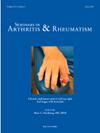Calcium pyrophosphate deposition is associated with an increased risk for nephrolithiasis: A cohort study
IF 4.6
2区 医学
Q1 RHEUMATOLOGY
引用次数: 0
Abstract
Background/Objective
Calcium pyrophosphate deposition disease (CPPD) is a type of arthritis affecting aging adults that presents with chronic and acute inflammatory and non-inflammatory joint disease. While the etiology of CPPD is not fully understood, recent work suggests that it may be associated with other mineralization disorders. In this retrospective cohort study, we investigated the hypothesis that the prevalence of nephrolithiasis is increased in patients with CPPD.
Methods
We used the National VA Corporate Data Warehouse to identify CPPD patients with at least one inpatient or outpatient ICD9 code for CPPD between January 1, 2010 and December 31, 2014. This disease cohort was age-, sex-, and date-matched to up to four controls. The presence of independent risk factors for nephrolithiasis was noted for both cohorts, including hyperparathyroidism, renal tubular acidosis, inflammatory bowel disease, short gut syndrome, and obesity (BMI > 30).
Results
A total of 18,761 CPPD patients were identified who were matched by age and sex to 75,043 controls, for a total sample size of 93,804 individuals. The average age of the cohorts was 68.5 years, with a predominant male demographic (94.3 %). The prevalence of nephrolithiasis was significantly higher in the CPPD cohort (8.6 %) compared to controls (5.1 %, P < .0001). Adjusted analyses revealed an odds ratio of 1.659 (95 % CI 1.560, 1.764) for nephrolithiasis in CPPD patients which remained significant after removal of patients with hyperparathyroidism.
Conclusions
These data suggest that CPPD is an independent risk factor for kidney stone formation and provide further support for the hypothesis that CPPD is a systemic disorder of mineralization with extra-articular implications.
求助全文
约1分钟内获得全文
求助全文
来源期刊
CiteScore
9.20
自引率
4.00%
发文量
176
审稿时长
46 days
期刊介绍:
Seminars in Arthritis and Rheumatism provides access to the highest-quality clinical, therapeutic and translational research about arthritis, rheumatology and musculoskeletal disorders that affect the joints and connective tissue. Each bimonthly issue includes articles giving you the latest diagnostic criteria, consensus statements, systematic reviews and meta-analyses as well as clinical and translational research studies. Read this journal for the latest groundbreaking research and to gain insights from scientists and clinicians on the management and treatment of musculoskeletal and autoimmune rheumatologic diseases. The journal is of interest to rheumatologists, orthopedic surgeons, internal medicine physicians, immunologists and specialists in bone and mineral metabolism.

 求助内容:
求助内容: 应助结果提醒方式:
应助结果提醒方式:


